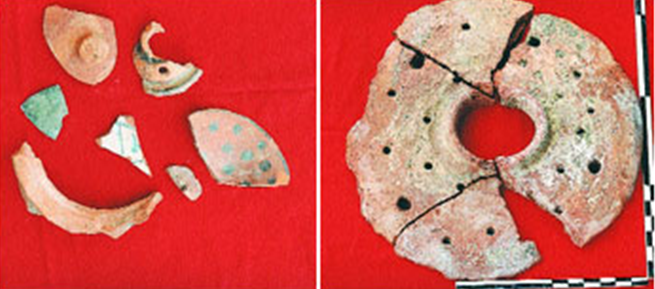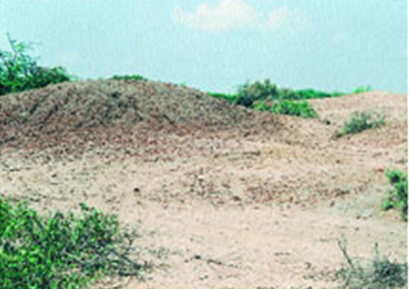Thar mound: Mohammad Alam Khaskheli Goth, Badin district
This is a collection of articles archived for the excellence of their content. Readers will be able to edit existing articles and post new articles directly |
Thar mound: Mohammad Alam Khaskheli Goth, Badin district
Precious discoveries … courtesy rains
By Bhagwandas
THE recent spell of torrential rains affected many areas and people in the country, and in different ways. Some areas were heavily flooded, like Hyderabad, where many localities remained submerged by water weeks after the rains had stopped, while some areas like the Thar, not to mention some other deserts, benefited from the rains recharging their subsoil aquifers, ensuring that people of the region would get drinking water for a considerable period of time.
While the majority of the people of the Badin district were affected by the heavy downpour coupled with breaching of the Left Bank Outfall Drain, some of them proved lucky and benefited tremendously when the rains washed away the upper soil from a mound and revealed archaeological treasures in the shape of coins, pottery and utensils, suggesting that the mound needed to be explored and excavated along scientific lines much earlier.
Interestingly, the Federal Archaeology Department was not only unaware of the location of the mound, but even a recent survey of the Badin district conducted by departmental officials could not discover the mound. It is the area from where the people residing in nearby villages had been finding precious objects for the past many years. The department woke up when the news of “archaeological discoveries” was carried by regional and local media.
The site, spreading over 20 acres, is located some five kilometres away from Rajokhanani, next to a small village, Mohammad Alam Khaskheli Goth, in the Badin district. Villagers say that they had been discovering things like coins, pottery, and skeletons from near the mound for a long time. Much to their amazement, after the recent rains they found an earthen pitcher containing a couple of hundred coins.
The villagers, on their own, had excavated the site long time back and had discovered the remains of a mosque, where they now say their prayers. They say that a nearby old graveyard has a peculiar aspect attached to it. Its graves are longer almost double the normal size of a grave, suggesting that probably the people in old times were taller.
A lot of charred bricks, broken pottery pieces, coins, rice, etc., can be seen scattered all around the mound. When the villagers come across skeletons, they bury them back. The villagers say that though a local landlord has taken over the area, it has not yet been properly checked and explored, something that the Archaeology Department must do.
The recent rain-related discoveries include seven pieces of terracotta pots, six pieces of a terracotta grain grinder, smudgy bricks (size 8 ½ x 81/2 x 1 ½ inches), terracotta balls, broken terracotta toys, and over one hundred copper coins. The villagers had first taken these things to their homes, but subsequently handed them to the Archaeology Department.
The department carried out a comprehensive survey from 1992 to 2006 and has discovered over 1,200 sites dating back to Old Stone Age II (Palaeolithic period) and to the British colonial period in 14 districts of Sindh. And the site from where coins have been discovered has not been mentioned in that survey, a report of which is yet to be published.
Once the report is published, these sites would be reviewed for their historical importance and based on these findings decisions regarding excavation and exploration would be taken. Here it needs to be mentioned that rapid and unchecked urbanisation is posing a grave danger to these sites. Roads are being constructed, which, no doubt, are necessary for development, but with easy access such treasures are becoming exposed to treasure/antique hunters. Some time back during a road excavation in Nagarparkar (the Thar Desert) some statues were found. They were taken away by some villagers and by Pakistan Rangers to their Veerawah check post. After the Archaeology Department came to know of these statues, it started making efforts to recover them. They were finally recovered and are now displayed at the Umerkot Museum.
The department also has a limited staff which is not sufficient to guard all its protected sites located in remote parts of the province. One of the important protected archaeological sites is the “Remains of the old city of Badin”, which was protected during the British era. It has now been encroached upon and is being used as an autak and a stable by a minister.
Discussing the subject with Sunday Magazine, Sindh Balochistan chief of Archaeology Department Qasim Ali Qasim said that all the objects that were discovered during recent rains from Rajokhanani town in the Badin district have been recovered from the villagers.

